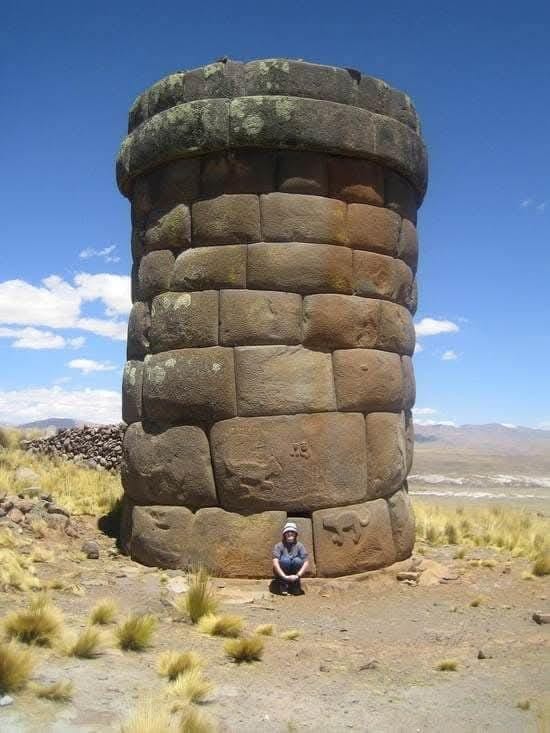High in the Peruvian Andes, where rugged peaks kiss the sky and ancient winds whisper through timeworn stone, stands one of the most captivating archaeological sites in South America—Sillustani. This sacred landscape, perched at an astonishing elevation of 3,840 meters above sea level, is not just a testament to the architectural brilliance of pre-Columbian civilizations but also to their deep spiritual connection with the land and cosmos. Overlooking the tranquil waters of Lake Umayo, Sillustani is home to the Chullpas—towering cylindrical stone structures that once served as tombs for the revered dead, now standing as silent guardians of a civilization’s enduring legacy.

The Chullpas of Sillustani rise with an almost ethereal grace against the backdrop of the Andean sky. These funerary towers, some reaching heights of 12 meters, were more than mere resting places; they were sacred monuments, constructed with precision and care, to house the mummified remains of nobles and important figures. Built first by the Colla people, a pre-Inca civilization known for their mastery of stonework, these towers encapsulate the ingenuity and reverence of a people who saw death not as an end, but as a transition to another realm. Within the sealed chambers of these Chullpas, the deceased were entombed with offerings of pottery, tools, and provisions—believed to assist them in their journey to the afterlife. These items were not chosen randomly; each artifact reflected both the status of the individual and the spiritual beliefs of a society attuned to the cycles of nature and the cosmos.
When the Inca Empire expanded into this region during the 15th century, they recognized the significance of these monuments and chose not to destroy them, but rather to enhance and honor them. The Inca builders brought with them advanced engineering skills and cosmological knowledge, refining the construction techniques used in the Chullpas. The result was a seamless fusion of two cultural legacies—pre-Inca and Inca—woven together in stone and spirit. The architectural enhancements made by the Incas included improved stone fitting and alignment, achieving a level of precision that continues to astonish modern-day archaeologists and engineers.
One of the most fascinating aspects of the Chullpas is the extraordinary craftsmanship with which they were constructed. Using finely cut stones fitted together without mortar, these towers have withstood centuries of weather and seismic activity. This level of stonework rivals even the most celebrated examples of Inca masonry found at places like Machu Picchu and Ollantaytambo. Many Chullpas also feature intricate carvings—images of serpents, pumas, and lizards—that held profound meaning in Andean cosmology. These animals symbolized various forces: serpents for the underworld and transformation, pumas for strength and leadership, and lizards for regeneration and fertility. These symbols suggest that the Chullpas were not just tombs but cosmic gateways, linking the physical and spiritual realms.
Even more remarkable is the astronomical orientation of many of these structures. Numerous Chullpas are aligned to face the east, toward the rising sun, a celestial event imbued with meaning in Andean belief systems. The sun, considered a powerful deity, symbolized life, renewal, and divine order. By aligning their funerary towers with solar events, the Colla and Inca peoples demonstrated a sophisticated understanding of astronomy, weaving it into the fabric of their daily lives and spiritual practices. This fusion of architecture and celestial observation speaks to the holistic worldview of these ancient cultures, where the earth, sky, and human experience were deeply interconnected.
Lake Umayo, lying peacefully beside Sillustani, was more than a scenic backdrop—it held sacred significance. Its calm, reflective surface likely symbolized a mirror to the heavens, a liminal space where the worlds of the living and the dead converged. The choice to build Sillustani here was intentional, a spiritual decision grounded in geography, cosmology, and reverence for the natural world. To stand at the edge of this lake, gazing at the Chullpas and the endless Andean sky, is to experience a sense of awe that transcends time—a connection to something ancient and eternal.
Today, Sillustani is not merely a collection of ruins; it is a living monument that continues to resonate with meaning. The local Quechua and Aymara communities honor the site, integrating it into cultural traditions and ceremonies. These modern connections underscore the continuity of Andean spiritual heritage, a lineage that persists despite centuries of change. Sillustani is a bridge between the past and present, a sacred space that invites reflection on the achievements, beliefs, and resilience of the peoples who once thrived in these highlands.
For visitors, Sillustani offers a profound encounter with history, art, and spirituality. It is a place where stone tells stories—of life, death, and the universe. As the sun dips below the horizon, casting golden light on the Chullpas and the shimmering waters of Lake Umayo, one can feel the presence of those who built and revered this place. In that moment, the ancient and the modern coalesce, and the power of Sillustani as a guardian of memory and meaning becomes undeniably clear. This remarkable site reminds us that while civilizations may rise and fall, the human quest to understand life, death, and the cosmos is eternal, etched forever into the enduring stones of the Andes.





